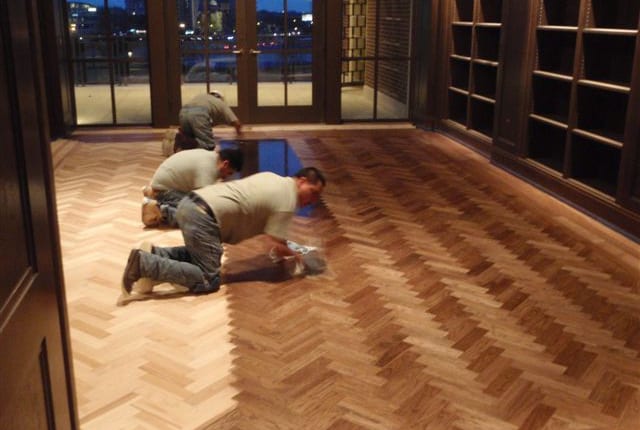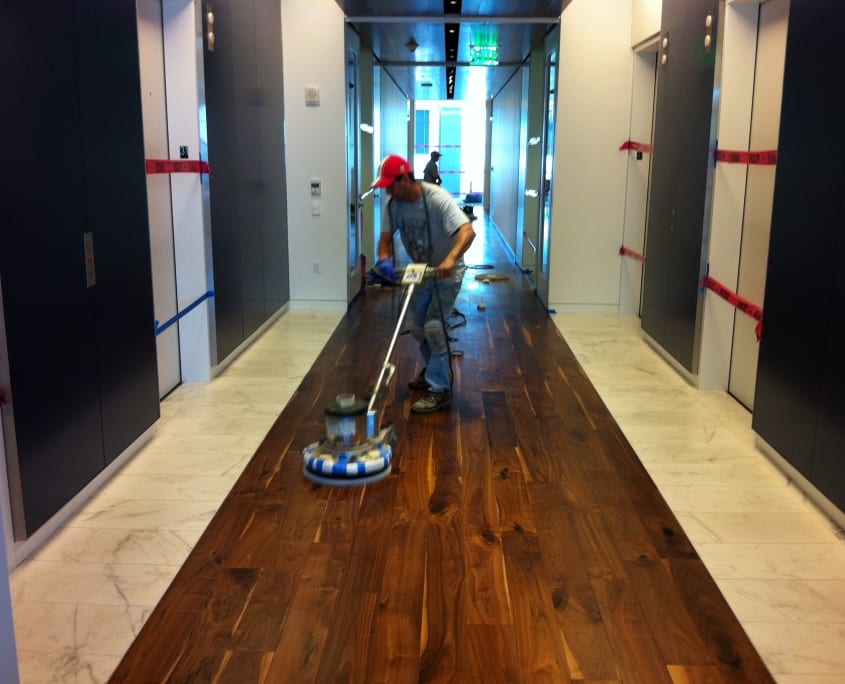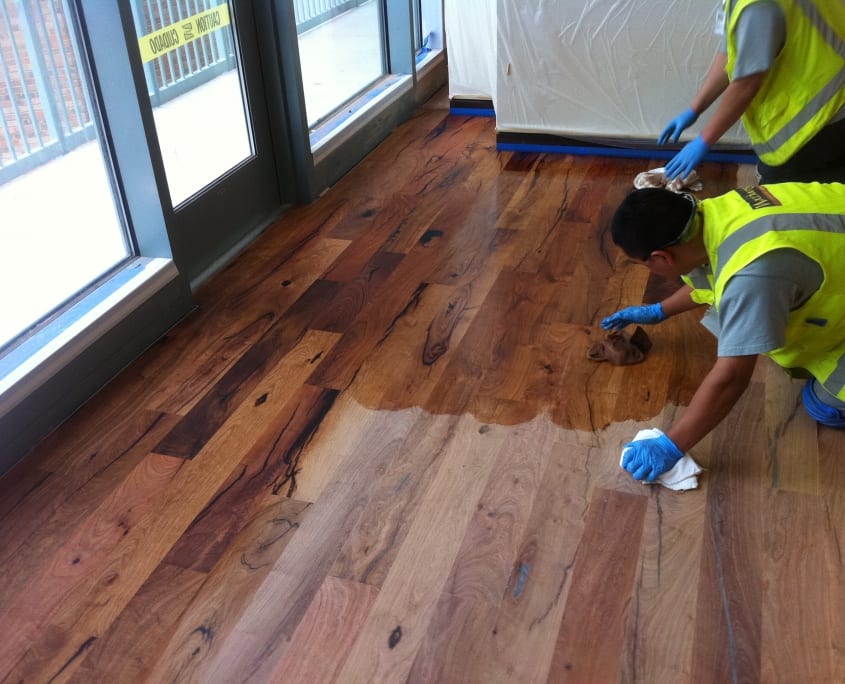When it comes to designing spaces that incorporate wood elements, the choices continue to grow. Whether it’s choosing a wood specie, cut, texture, color or floor finish, there are pros and cons to everything. So how do you make a selection to create the desired aesthetic?
At Woodwright, our approach has always been to educate the A&D community on the pros and cons of their selections so that decisions are made in the best interest of their clients. Selecting an appropriate hardwood floor product (regarding the stain and finish used), is vital for the longevity of your project – especially when it comes to designing commercial spaces.
Reactive Products
Fumed or Smoked – Tannin Acid Reactors
- Traditional methods of aging wood involved chambering the planks together with ammonia which reacts with the naturally occurring tannins, primarily on White Oak which has a high level of tannin in comparison to other species. This reaction causes the wood to change color and often creates instant Patina.
- Due to regulations, more modern techniques have been developed that involve topical applications of less dangerous tannin acid reactors.
- Both methods create a similar effect however, neither penetrates the wood deep enough to guarantee a uniform color if ever sanded and refinished.
Thermal Treated
- Also referred to as carbonized or baked, wood is heated to 400+ degrees in an environment free of oxygen. This non-toxic, natural process caramelizes the sugars and tannin acids in certain species totally changing the make-up of the wood. As a result, the wood becomes very rot resistant and much darker in color.
Perfect for making Poplar (an inexpensive specie) look like Walnut, for example. - Unfortunately, the wood can become brittle due to the change in its cell structure, possibly causing chipping or splintering.

Reactive Stains
- This technique/product is used to create custom colors through an oxidative reaction between the dissolved minerals and the tannins in wood.
- PROS of Reactive products are the ability to create unique colors, aged, patina and two-tone effects.
- CONS of Reactive products mostly involve repairability. The initial color is a moving target as it often fades and changes over time and is affected by heat. This makes it very challenging to replace or reproduce matching planks in the future.
It is quite common for wood floors that are colored using reactive techniques to be top coated with European Hard Wax Oil finishes. You guessed it! There are pros and cons to your finish selection as well.
Hard Wax Oil Finishes
European style oil finishes are gaining popularity due to their inherent matte sheen and natural look. Oils penetrate into the woods open cell structure, so you walk on the wood, not the finish.

- PROS – The biggest advantage they offer is ease of repairability. Simply clean the floor and apply a refresher or fresh coat of oil.
- CONS – Oil finishes require a rather complicated maintenance process, usually utilizing 2 mop buckets and a diluted soap product.
- This may not be a problem in residential projects where the maintenance can actually be controlled.
- Commercial projects have much less control over proper maintenance long-term.
Carefully consider whether the elevated maintenance requirements of an oil finish will meet the demands of your project, especially in commercial spaces.
Urethane Finishes
The most common floor finish is Urethane. It is a true top coat in that it creates a coating or barrier on top of the wood.

- PROS – Most notable is the increased durability. Far more durable and protective than Oil. Ease of maintenance is another benefit… that is if your client cares about maintenance! Highly recommended for pastel floors or closed grain species. Ex: Maple. Contains UV inhibitors to prolong potential fading and color change by UV rays.
- CONS – Repairability! Scratches, dents or excessive wear can be very difficult to spot repair. Repairing a site finished urethane floor often requires the entire area to be sanded and refinished. If the floor is prefinished it can be patched by simply replacing a board.
Urethane floors are easily cleaned by merely dust mopping, using a vacuum with the rotary bristles turned off or with a non toxic wood floor cleaner like Bona Hardwood Floor cleaner.
It is imperative to avoid using products containing soaps, oils or harsh chemicals that may leave a residue or damage the protective coating.
Longevity

Color selection is only one piece of the puzzle when it comes to deciding on the right wood floor for your project. Other important factors are intended traffic, required durability and, of course, meeting client’s expectations… especially when it comes to maintenance and wearability.
Every Designer needs a “go to” wood expert… at Woodwright your dedicated A+D consultant is happy to assist you in selecting the correct product and attributes that best suits your project needs.
